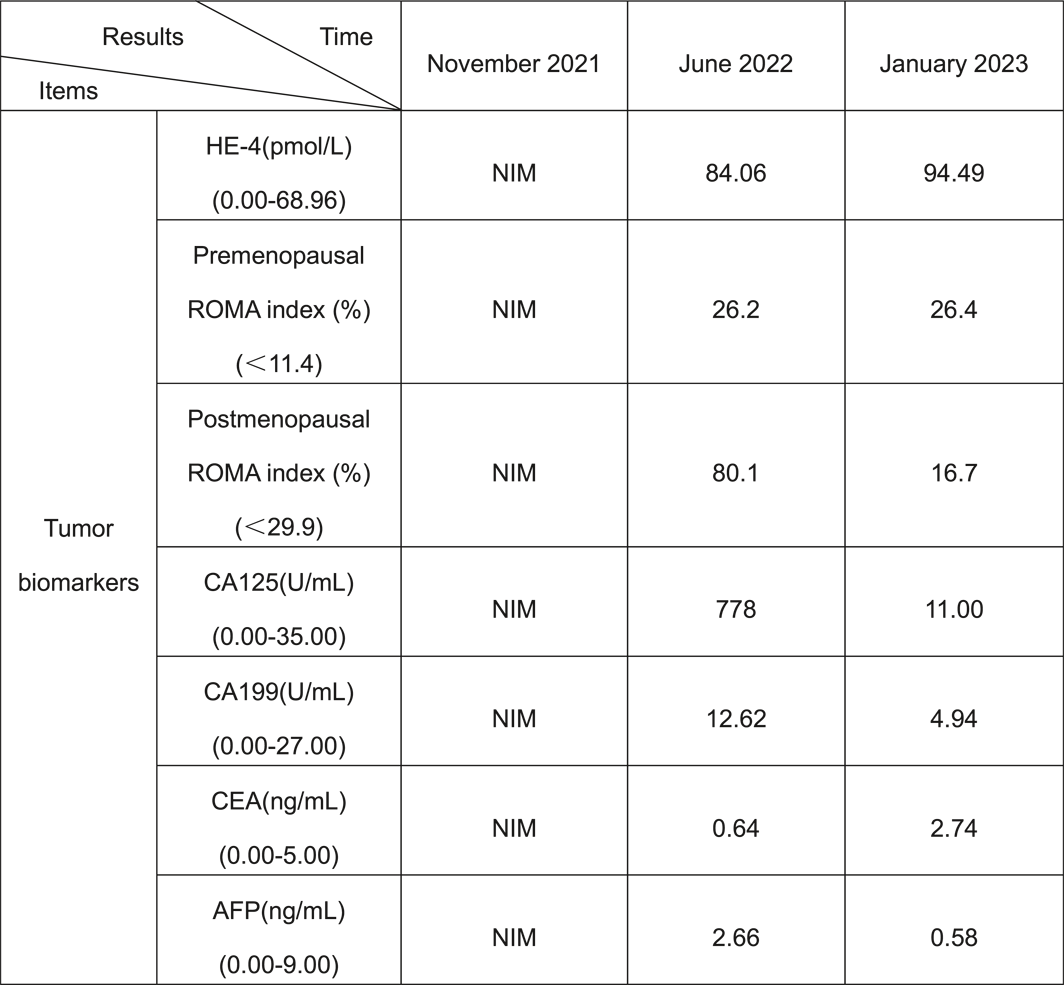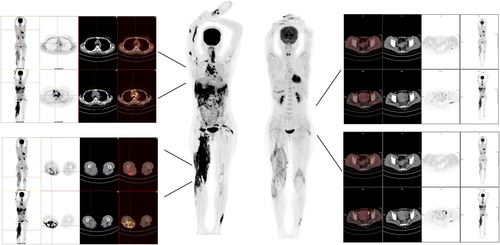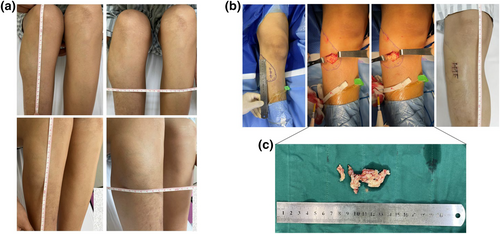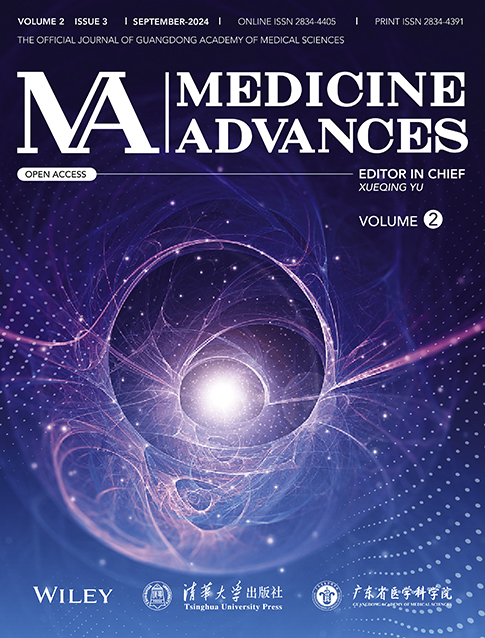Anti-synthetase syndrome complicated by multifocal tuberculosis: A thought-provoking differential diagnosis with tumors
Abstract
Mycobacterium tuberculosis, which mainly affects the lungs but can also invade other systems, presents a diagnostic challenge when co-existing with autoimmune disease. We report a case of 31-year-old Asian woman with anti-synthetase syndrome who developed abdominal and subcutaneous lumps during treatment, along with elevated tumor markers, raising suspicion of malignancy. Pathological examination revealed M. tuberculosis infection, changing the diagnosis to multifocal extrapulmonary tuberculosis. This case highlights the need for prompt and detailed evaluations, and the importance of broad differential diagnosis.
Abbreviations
-
- AFP
-
- alpha fetoprotein
-
- ASS
-
- anti-synthetase syndrome
-
- CA
-
- carbohydrate antigen
-
- CEA
-
- carcinoembryonic antigen
-
- EPTB
-
- extrapulmonary tuberculosis
-
- HE-4
-
- human epididymis protein 4
-
- NGS
-
- next-generation sequencing
-
- NIM
-
- no inspection made
-
- ROMA
-
- risk of ovarian malignancy algorithm
-
- TB
-
- tuberculosis
1 INTRODUCTION
Although the treatment of tuberculosis (TB) is no longer a medical problem, diagnosing TB in clinical practice remains challenging. Extra-pulmonary TB (EPTB) is often confused with neoplastic disease because of its atypical manifestations. The fields of TB and oncology are closely intertwined; both conditions share overlapping clinical, radiological, and pathological features, often leading to diagnostic dilemmas [1]. Understanding this interplay is essential for accurate diagnosis and improved patient outcomes. This report reviews the correlation between TB and tumors and aims to distinguish their characteristics to optimize disease management and patient care.
2 CASE PRESENTATION
2.1 Medical history
A 31-year-old Asian woman experienced persistent joint pain in all four limbs for over 1 year. In October 2021, she developed generalized joint pain, particularly in the upper limbs, and stiffness in both hands, making it difficult to extend her fingers. In November 2021, she sought medical attention and was diagnosed with anti-synthetase syndrome (ASS) in accordance with the international diagnostic criteria [2, 3]. This diagnosis was based on her symptoms of symmetrical polyarthritis, interstitial lung disease, and the presence of positive anti-cytoplasmic aminoacyl-tRNA synthetase antibodies (notably anti-Jo-1 antibodies). She was treated with a standard regimen of methylprednisolone, methotrexate, cyclosporin, immunoglobulin, tacrolimus, and cyclophosphamide. Despite treatment, she developed bilateral thigh and calf muscle pain, fever, stiffness, and difficulty squatting, leading to two falls.
In June 2022, a reassessment confirmed ASS, and treatment was adjusted to include methylprednisolone, methotrexate, rituximab, and tofacitinib, alleviating muscle pain but not weakness. During hospitalization, she developed intermittent fever (39°C–40°C) and painful swelling in the right elbow, indicating a possible infection. Next-generation sequencing (NGS) revealed multiple viruses in her blood, leading to antiviral treatment with ganciclovir and famciclovir. Unexpectedly, subsequent nucleic acid tests showed no abnormalities for these viruses. Because of the suspiciously positive results of tests for some TB indicators, she received empirical antibacterial treatment until another muscle biopsy with repeat NGS showed no TB evidence. Due to persistent high fever and abnormal elevation of certain tumor markers (Table 1) coupled with her unremarkable gastroscopy and gynecological ultrasound results, further comprehensive assessment utilizing positron emission tomography/computed tomography was initiated. The results suggested a possible malignancy originating from the uterus adnexa, potentially involving metastasis or lymphoma infiltration (Figure 1). We suspected that the high fever might be of cancerous origin and implemented additional diagnostic procedures to ascertain the presence and scope of the disease. She was then transferred to the gynecology department and underwent single-port laparoscopic left salpingectomy, left pelvic peritoneal lesion resection, and partial omentectomy to excise the primary source of potential malignancy, alleviate the high fever and related symptoms, and prevent cancer proliferation. This approach was strategically implemented to address both the immediate and future ramifications of the malignancy and to ensure a definitive diagnosis. Post-surgery, her fever resolved. Interestingly, the tissue pathologic examination revealed granulomatous inflammation in the left pelvic peritoneum, omental tissue, and left fallopian tube, with positive acid-fast staining. Cytokine tests confirmed double positivity for interferon gamma and interleukin 2, leading to a revised diagnosis of abdominal TB. Therefore, standardized quadruple-drug anti-TB treatment was initiated for 8 months, but pyrazinamide was discontinued after a month due to elevated uric acid levels.
 |
- Abbreviations: AFP, alpha fetoprotein; CA, carbohydrate antigen; CEA, carcinoembryonic antigen; HE-4, human epididymis protein 4; NIM, no inspection made; ROMA, risk of ovarian malignancy algorithm.

Comparison of PET/CT images. Top left: Comparison of lungs before and after treatment. Bottom left: Comparison of right thigh muscles before and after treatment. Middle: Images at initial onset of disease and after surgery. Top right and bottom right: Comparison of pelvic cavity before and after treatment. Abbreviation: PET/CT, positron emission tomography/computed tomography.
In October 2022, the patient experienced recurrent joint pain in all four limbs, similar to previous episodes. Additionally, she developed swelling in the lower right knee and upper fibula without increased skin temperature, pain, or functional impairment. Admission examination results are shown in Figure 1, with details of three inpatient stays in the Supporting Information S1.
2.2 Major physical examination
Peripheral joint examination showed mild redness, swelling, and tenderness in both small and large joints of all four limbs. The bilateral thigh and calf muscles were stiff and tender, especially in the posterior right thigh. A soft, painless, fusiform mass was observed below the right knee and upper fibula region. Mild pitting edema was present in both lower extremities.
2.3 Treatment process
We surgically excised the right lower limb mass for a definitive diagnosis. The excised material was yellowish, soft, and irregular (Figure 2). NGS of the tissue revealed a Mycobacterium tuberculosis complex. Considering the patient's clinical course, she was diagnosed with multifocal TB, with the lower limb mass identified as a tuberculous cold abscess. Therefore, her anti-TB treatment was reinitiated and the treatment duration extended to 1.5 years. Based on the examination results, we attributed her recurrent arthralgia to M. tuberculosis infection-associated reactive arthritis. Treatment with etoricoxib reduced her discomfort.

Images of right lower limb mass. (a) Right lower limb mass at initial admission. (b) Surgical resection of right lower limb mass. (c) Gross view of excised right lower limb mass.
3 CONCLUSION
ASS, also called anti-Jo-1 antibody syndrome, is a complex autoimmune disease characterized by the presence of anti-aminoacyl-tRNA synthetase antibodies and a cluster of specific clinical manifestations, including myositis, interstitial lung disease, arthritis, Raynaud's phenomenon, and mechanic's hands [2, 4]. Diagnosis and treatment of ASS is uniquely challenging because of its variable presentation and similarities to conditions such as tumors and infections. Both TB and tumors can instigate a paraneoplastic or reactive response, mimicking autoimmune disease and complicating the diagnosis. Hence, the integration of clinical, serological, imaging, and histopathological information is essential for accurate diagnosis and treatment. TB, caused by M. tuberculosis, primarily affects the lungs but can also affect extrapulmonary sites, including lymph nodes, bones, the central nervous system, as well as the peritoneal, gastrointestinal, renal, and genitourinary tracts [5]. EPTB elicits immune responses similar to those triggered by tumors [6]. Microorganisms or their components may stimulate autoantibody production, setting off an autoimmune cascade. At the cellular level, both conditions often result in granuloma formation in TB and desmoplastic reactions in tumors. Chronic inflammation, a key component of TB, can also foster a tumorigenic environment, thus potentiating tumor development. Furthermore, epidemiological studies suggest higher TB prevalence among cancer patients due to immunosuppression from malignancy and its treatments. Both conditions can cause comparable symptoms (e.g., weight loss, fatigue, night sweats) and present as nodules or masses on imaging, complicating differential diagnosis. Caseating granulomas in TB may mimic the necrotic areas of malignancy on histopathology. Nevertheless, profound differences also exist. Unlike tumors, EPTB spreads via droplet, gastrointestinal, or mother-to-child transmission and is primarily treated with antimicrobial therapy, while tumors require varied treatments based on type, stage, and location [7]. Molecularly, EPTB is an infectious process, whereas tumors arise from genetic and epigenetic changes leading to uncontrolled cell growth [8]. The radiographic features of EPTB often overlap with those of tumors, complicating differentiation based solely on imaging. For example, tuberculous lymphadenitis, osteomyelitis, and abdominal TB can mimic lymphoma, bone tumors, and peritoneal carcinomatosis, respectively. Diagnostically, sputum cultures and polymerase chain reaction are used for the detection of M. tuberculosis, whereas tumors require biopsy and subsequent histopathological examination. In actual clinical practice, EPTB diagnosis is challenging due to its paucibacillary nature, necessitating high clinical suspicion, imaging, and invasive procedures for tissue diagnosis [9]. This complexity is further accentuated in the context of a single case study, in which we have highlighted the limitations inherent to such an approach.
In conclusion, despite the distinct etiologies and pathogenic pathways of TB and tumors, their intersections across various domains present significant challenges in differentiation. Recognizing these correlations and distinctions is crucial for optimal patient management. Early pathological assessment enhances diagnostic accuracy and tailors patient-specific management plans. Further exploration of the immunological and molecular intersections between these two conditions might yield novel therapies and better patient outcomes.
AUTHOR CONTRIBUTIONS
Chang Dai: Methodology (lead); resources (lead); writing—original draft (equal); writing—review & editing (equal). Yu Jiang: Writing—original draft (supporting); writing—review & editing (supporting). Weidong Lin: Conceptualization (equal); data curation (equal). Yuhan Chen: Conceptualization (equal); data curation (equal). Fangzhou Liu: Conceptualization (equal); data curation (equal). Hai Deng: Conceptualization (equal); data curation (equal). Yanlin Chen: Conceptualization (equal); data curation (equal). Haowei Chen: Conceptualization (equal); data curation (equal). Jieying Wang: Conceptualization (equal); data curation (equal). Yunxia Lei: Supervision (equal); validation (equal). Shulin Wu: Supervision (equal); validation (equal). Yumei Xue: Supervision (equal); validation (equal).
ACKNOWLEDGMENTS
None.
CONFLICT OF INTEREST STATEMENT
The authors declare no conflict of interest.
ETHICS STATEMENT
Not applicable.
INFORMED CONSENT
We provided care for the patient and managed the case. Written consent for publication was obtained from the patient.
Open Research
DATA AVAILABILITY STATEMENT
The data that support the findings of this study are available on request from the corresponding author. The data are not publicly available due to privacy or ethical restrictions.




